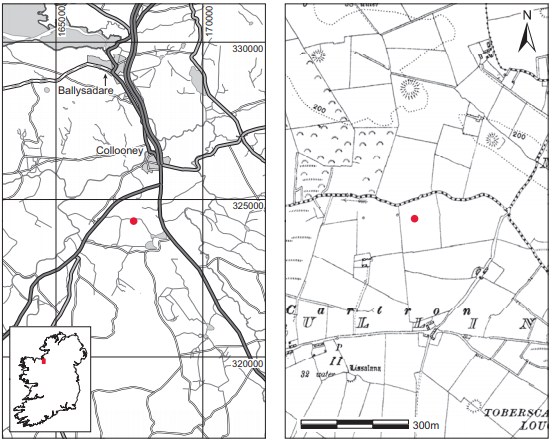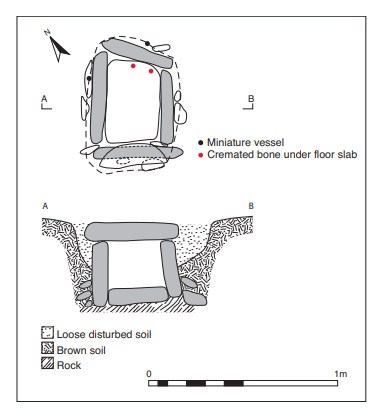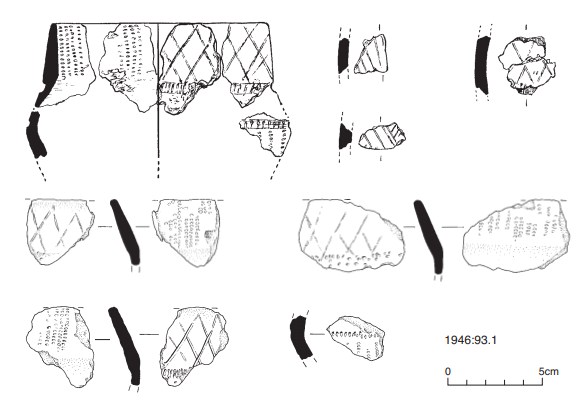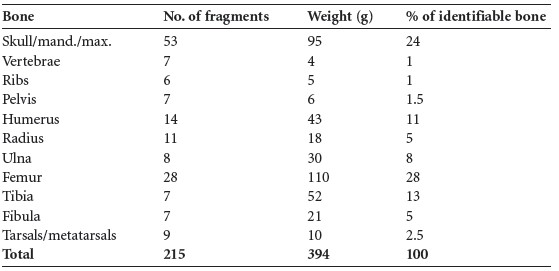County: Sligo Site name: KNOCKMULLIN, CO. SLIGO
Sites and Monuments Record No.: SMR SL026-152SMR SL026-030 Licence number: E1157
Author: ELLEN PRENDERGAST
Site type: Early Bronze Age graves
Period/Dating: —
ITM: E 567434m, N 824328m
Latitude, Longitude (decimal degrees): 54.166900, -8.498701
Introduction
In April 1946 a short cist containing a cremation and some sherds of pottery was discovered during ploughing near Collooney, Co. Sligo. It was found at a depth of approximately 0.15m when a large stone that had been noticed during ploughing for many years was removed to reveal a cist underneath. The landowner, Mr John Doyle, left the cist intact, but the contents were disturbed by visitors to the site. The site was visited by members of the Sligo Archaeological Society, who noticed bones scattered on the surface around the cist. They emptied the cist and found one sherd of pottery, which they forwarded to the Museum. The bones were put back in the cist and the capstone replaced. A one-day rescue excavation was undertaken by Ellen Prendergast on 10 April 1946. This report is based on Prendergast’s account of the site. The human remains were analysed by Laureen Buckley.

Location (Fig. 3.165)
The site was in the townland of Knockmullin, east Co. Sligo, just over 2km south of Collooney village.299 It was at an altitude of 40–50m above sea level, approximately 1km north-west of Toberscanavan Lough. No burials of similar date are known from the townland, but one cist was excavated in Ballygrania townland, some 7km to the north-east.300
Description of site
The grave was subrectangular in plan, with its long axis aligned north-east/south-west. Internally, it measured 0.51m long by 0.31m wide by 0.25m high (Fig. 3.166). It was constructed of four main edge-set slabs, with one forming each wall. These appear to have been relatively regular in shape and were flanked externally by smaller packing stones. According to the landowner, a slab had been placed flat between the south-western side slab and the capstone.301 The north-eastern end stone was placed at a slight angle to the two side stones. The cist was sealed by a large, subrectangular capstone, 0.71m long by 0.48m wide by 0.1m thick. The floor of the cist was paved with a single flat slab approximately 0.08m thick. The pit dug to receive the cist measured 0.75m long by 0.71m wide.
The grave contained the cremated remains of an adult male (1946:93.2) and ten sherds of pottery.302 Unfortunately the remains were not in situ when excavated, and a significant portion of the bone lay around the outside of the cist. Cremated bone was also found underneath the floor slab.303 Two sherds of pottery were recovered outside the cist, quite close to the side stones, and six small sherds from a miniature vessel and a tiny piece of charcoal were found in the disturbed soil close to the outside of the cist.
Miniature vessel, 1946:93.1 (Fig. 3.167)
The ware is fine with small grits; it is reddish-buff throughout, thin-walled and well fired. The rim is plain, rounded but not thickened. It appears to have a straight, upright neck, but since none of the pieces join together this is not certain. There is a restriction at the base of the neck and then the vessel expands as if it had a globular body. The pieces from the body are too small to give the curvature. The small fragment with shouldered profile cannot be placed in position. The neck is ornamented on the inside with a series of oblique rows of ‘comb impressions’; these are repeated at the restriction at the base of the neck and again on the shouldered fragment. There is an incised trellis pattern on the neck externally. Similar incised lines appear on the body sherds. No fragments of the base survive.
Dimensions: est. D rim 12.6cm; T wall c. 5mm. The dimensions of the largest fragment are 5.5cm by 4cm.
Comment
The sherds have been described as having ‘beaker-like affinities’ (Cremin Madden 1968, 20). Waddell (1998, 119) says that the classification of the pottery from Knockmullin is ‘debatable’. Following a recent examination by Dr Alison Sheridan, the sherds have been identified as parts of a miniature vessel. The sherds are similar in form and decoration to some vase urns, and the vessel, when complete, most likely resembled a miniaturised vase urn such as the example from Greenhills, Co. Dublin (Kavanagh 1977, 69).
HUMAN REMAINS
LAUREEN BUCKLEY
Introduction
Sample 1946:93.2 consisted of 255 fragments of cremated bone, weighing a total of 466g. This is a moderate amount of bone compared to other Bronze Age cremations, but it is considerably less than the 1,600–3,600g expected from a full adult cremation (McKinley 1989). It is possible that some bone has been lost from the original sample, however. Even though the cist was disturbed, descriptions by Ellen Prendergast indicate that it was half-filled with bone and soil and that further bone was found in the surrounding ploughsoil. The amount of bone present in the sample seems much less than would be expected from this description.


It is possible that, as the bone was sent to Professor E.J. Keenan, he separated out the larger pieces and that this is the only sample now available.
The bone was well calcined, creamy white in colour, with some warping of the long bones. There was a small amount of fissuring of the surface. Some of the fragments were very white with a chalky texture. Several of the fragments seemed to be encrusted with a mineral concretion, suggesting that the cist had been waterlogged from time to time.
Fragmentation
The fragmentation is shown in Table 3.99, with the largest fragment being 85mm in length.
Table 3.99—Fragmentation of bone, 1946:93.2.

It can be seen that there is a significant proportion of very large fragments, and the larger fragments, more than 25mm in length, represent 74% of the cremated remains. Therefore it is highly unlikely that the bone was deliberately crushed after collection from the pyre; fragmentation occurred along fissure lines during collection and deposition of the bone. The lack of smaller fragments suggests that only the larger fragments were collected when the bone was processed and that small fragments were considered of no significance and were ignored.
Identifiable bone
The lack of crushing of the bone is reflected in the amount that could be identified—a total of 394g (84.5% of the total bone) (Table 3.100). Table 3.101 summarises the main parts of the skeleton identified from this sample. It can be seen that although the proportions of skull and upper limbs are only slightly higher than expected, the lower limbs are overrepresented at the expense of the axial skeleton. It seems that the vertebrae and ribs were not well collected, but the larger, more obvious bones such as skull and long bones were. This may not necessarily represent the way the bones were collected from the pyre but may be more indicative of the way they were processed after excavation.
Description of identifiable features of the bones
Skull
A fragment of left orbital rim from a frontal bone was present and the thickness of the rim indicates that it may have been from a male. There were several fragments of parietal bone present, some with the coronal suture present and some with the sagittal suture visible. Two large fragments of occipital bone with the lambdoid suture visible were also present. The external occipital protuberance may have been of the male type. Part of the left mandibular fossa of the temporal bone was present, as well as part of the zygomatic arch, a fragment of a mastoid area and a fragment of squamous temporal bone. The right greater wing of the sphenoid bone was also present.
Table 3.100—Proportion of identified bone, 1946:93.2.

Table 3.101—Summary of identified bone, 1946:93.2.

Mandible and maxilla
One large fragment of the left side of the mandible with part of the ramus was present, as well
as a mandibular condyle. A small section of the right side of the maxilla was also present.
The following tooth sockets were present:

There were no tooth fragments present. This is a consequence of not collecting the smaller fragments. It is very common to find several tooth roots and enamel fragments in Bronze Age cremations and they are usually among the smaller fragments, less than 10mm in length.
Vertebrae
There was a large fragment of one cervical body, one thoracic body and part of one thoracic arch, as well as one fragment of sacrum.
Ribs
Most of the fragments were from the shafts, but there was one fragment with the transverse articular surface present.
Pelvis
There was a large fragment of the right ischium with part of the inferior edge of the acetabulum present. One other fragment of acetabulum and several other fragments of ilium were also present.
Humerus
All the fragments were from the shaft, some from the proximal end of the bone and some from the middle of the bone.
Radius
All the fragments were shaft fragments.
Ulna
There were several fragments of shaft, including one large fragment from the distal third of the shaft with part of the distal joint surface present. One fragment had bright green stains, which may indicate contact with a metal such as bronze. The distal joint surface had some marginal lipping present, which may indicate degenerative joint disease.
Femur
Several fragments of shaft with a pronounced linea aspera were present. There was also one fragment of neck and one fragment of the proximal joint surface. Two of the fragments from the back of the shaft were blue in colour, indicating less efficient cremation. This can occur if a bone is lying close to the ground and not enough oxygen can flow around it for efficient cremation.
Tibia
One large fragment from the anterior surface of the shaft was present, as well as a fragment from the posterior shaft near the nutrient foramen. There was also a fragment from near the distal end of the shaft and some other, smaller shaft fragments.
Fibula
Only fragments of shaft were present.
Tarsals/metatarsals
Some fragments of a talus and a calcaneus bone were present. There was also most of a first metatarsal, shafts of three other metatarsals and a first proximal phalanx.
Minimum number of individuals
Since there was no repetition of skeletal elements, the number of individuals present is one. From the size of the bone and the fact that most of the joint ends present appeared to be fused, it seems to be an adult individual. The only feature present that would enable sex to be estimated was the external occipital protuberance, which appeared to be of the male type. The linea aspera at the back of the femur was well developed, and as this provides attachment to the muscles of the upper leg it is usually more developed in males than in females.
Summary and conclusions
This represents the cremation of one, probably male, adult individual. There was evidence of degeneration in one joint so he may have been an older individual, although this is very tentative. The remains were carefully collected from the funeral pyre and were not deliberately crushed. It is highly likely, given the nature of the sample examined, that most skeletal elements were recovered and placed in the cist. It seems likely that small fragments were not retained when the cremation was processed or when it was examined by Professor E.J. Keenan. This has resulted in no tooth fragments or small bones of the hands being retained for examination.
299. Parish of Ballysadare, barony of Tirerrill. SMR SL026-152——. IGR 167476 324321.
300. SMR SL026-030——. IGR 169470 326020.
301. The position is marked as uncertain on Prendergast’s plan.
302. In her analysis of the human remains from the site, Buckley noticed that one fragment of ulna had bright green staining, possibly indicating some contact with metal such as bronze (see p. 464). No trace of any such metal was found by Prendergast.
303. This was thought by Prendergast to be as a result of some bone falling through the crevices between the floor slab and the side stones.